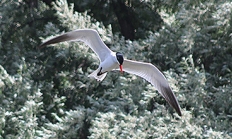Search myodfw.com
These chunky medium-small shorebirds are quite colorful in oranges and browns during most of their time in Oregon, where they are found mainly along the coast and locally in muddy areas inland. Their feeding motion has been likened to a sewing machine as flocks move slowly through shallow water and wet mud, probing with long straight bills. They are occasionally seen in marginal areas such as flooded pastures, but less likely than Long-billed to use such upland locations. They are a common to locally abundant coastal migrant, less common and more local in western interior valleys, and rare bur regular
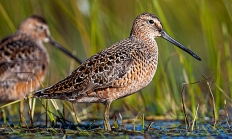
This medium-sized shorebird is the most common dowitcher in eastern Oregon and inland locations, where it sometimes gathers in large flocks feeding in shallow water. It is also the only dowitcher in the state that regularly winters. Although breeding plumage adults are reddish below and heavily patterned above, most birds seen in Oregon are duller postbreeding adults or browner immatures. During winter, when shorebirds are hard to find, a small flock of chattering dowitchers, even in plain gray basic plumage, often brightens a day in western Oregon. In migration, it can be found at almost any shallow water site in

Cryptically colored, usually solitary and somewhat secretive, the Wilson snipe is often flushed before being seen, sometimes exploding from practically underfoot and rocketing off in a corkscrew flight. This plump-bodied, long-billed bird of open marshland is primarily crepuscular, peaking in feeding activity at dusk and dawn, and often sleeping during the day. In breeding season they become more flamboyant, appearing atop fence posts and displaying their unique winnowing flights from high in the air, their outer tail feathers vibrating with an eerie whistling sound. They are uncommon and local west of the Cascades in the summer and uncommon and local

This is the largest and most terrestrial of the three species of phalaropes in Oregon. It is similar in shape to other Phalaropes, but larger size, longer bill and neck, lack of bar on the wing, and white rump distinguish it. In adaptation to a more terrestrial life than other Phalaropes, its toes are fringed, not lobed. It is a common transient and breeder east of the Cascades. The largest numbers breed on the great marshes of southeast Oregon. They are rare visitor west of the Cascades. Hear the call of the Wilson's phalarope Photo by Charlotte Ganskopp
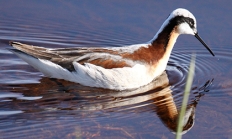
The thick, dense feathering on its underparts allows this dainty shorebird to float high on the water. Its lobbed toes give it considerable maneuverability while swimming. It is equally at home on the roughest seas and the smallest farm pond. A highly sociable bird and extremely trusting. Smaller size and slender bill separate this species from the Wilson's and Red phalaropes. Offshore it concentrates along tide rips and over upwellings. In shallow waters it stirs the bottom with its feet or spins rapidly to expose the tiny organisms that it picks up with its needlelike bill. An opportunistic forager of

Flying over the water in small flocks or riding the ocean swells like puffs of down, a more incongruous picture can hardly be imagined than these dainty mites riding the waves during rough weather, apparently entirely indifferent to the tumult of waters. Pelagic shorebirds, they come to shore only to breed. Adapted to life on the sea, they have glands that allow them to expel salt from the seawater they drink, and lobed, coot-like toes to swim. Brick red in their breeding plumage, they are mostly gray and white in winter. They are uncommon to common spring and fall transients
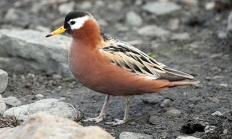
Gulls and terns can be seen year-round in Oregon, depending on the species. Gulls like open areas around water bodies and are frequently seen where human food is concentrated, such as dumps or restaurants. Terns are in the same family and usually are smaller and more slender.

Graceful and tern-like in many of its actions, this striking little gull displays flashing white outer primaries that contrast with a gray back. The Bonaparte's gull is an abundant spring and fall transient along the coast, primarily over the ocean just offshore and is fairly common and widespread elsewhere in Oregon, usually in flocks of less than 100. Larger flocks of up to 1,000 have occurred at Fern Ridge Reservoir in Lane County, during extreme storm conditions, and in the Klamath Basin. Hear the call of the Bonaparte's gull Photo by Martyne Reesman, ODFW

Heermann's gulls, the warm-water gulls of summer and fall, accompany Brown pelicans as they fly north each summer. Although most feed along the shore or in the ocean, some feed on tide flats. They often steal food from Brown pelicans. They may take fish directly from the pelicans' bills immediately after a dive or claim food that pelicans have located, discarded, or disturbed. This gull is common on the outer seacoasts, beaches, bays and estuaries. They are strongly associated with outer coasts and adjacent ocean waters, usually within a few miles of shore. A few wander inland during the fall

This small, gentle looking gull is one of the most abundant wintering gulls along the Pacific coast. It is often found foraging in mixed flocks with Ring-billed, and to a lesser extent, California gulls. Its small plover-like head and bill, and the habit of bobbing its head while walking, make it fairly easy to identify. It is most often found actively foraging with similar-sized gulls on coastal farm fields and short grass meadows and lawn when such habitat is moist. This is an abundant migrant and winter visitor along the coast, the lower Columbia River and in the Willamette Valley
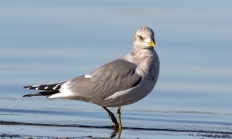
This is a colonial species that uses rocky islands or spits in large freshwater marshes, lakes, and rivers for nesting. It may fly at least five miles from the nest to forage in marshes, rivers, pastures, or other open habitats. There are colonies of Ring-billed gulls at marshes of southeastern Oregon and on islands in the Columbia and Snake rivers. There has been a colony near Baker City for over 20 years. Hear the call of the Ring-billed gull Photo by Kathy Munsel, ODFW
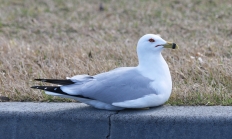
California gull colonies are usually located on islands with no vegetation in lakes or rivers. Sometimes colonies are on the shore, but these are subject to increased predation from mammalian carnivores. There are several large colonies of California gulls in the southeastern marshes, and at least 5,000 gulls nest on islands in the Columbia River. Smaller numbers nest on islands in the Snake River near Ontario, in Malheur County. Hear the call of the California gull Photo by ©Greg Gilson
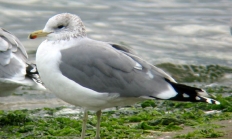
Identification of the large pink-footed gulls (Herring, Thayer's, Glaucous-winged, Western and Glaucous) along the West Coast is difficult. They are a common migrant and winter visitor offshore. Moderate numbers also winter in the Willamette Valley, concentrating with other gulls and landfills and other food sources and are most common around Portland and Eugene. Hear the call of the Herring gull Photo by ©Greg Gilson
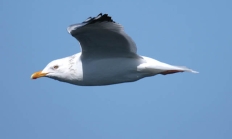
This mid-sized, pink-legged gull has caused much of the confusion in west coast gull classification and identification. Its plumage characteristics are similar to Herring, Iceland, and some Glaucous-winged hybrids, and great care is needed for correct identification. It differs from the Herring gull in having a much smaller bill, a darker eye, less black in the wing-tips and, often, a more rounded head. Opportunistic feeders, Thayer's gulls regularly concentrate about landfills, food-processing plants, and over fish runs. It is a common migrant and fairly common winter visitor along the coast. The largest wintering numbers are found in the Portland metropolitan
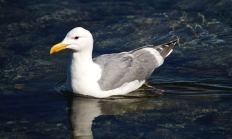
This is a marine gull that breeds on both offshore islands and rocky cliffs along the Oregon Coast. It also uses structures for nesting and, occasionally, will nest on grass-covered headlands. The Western gull's food comes from the marine environment, estuaries, and the immediate shoreline. It eats small fish, clams, mussels, bird eggs, the young of other birds nesting nearby, sea urchins, starfish, squid, crustaceans, marine worms, and carrion. it will scavenge garbage or waste from fishing boats as well. It is present all year along the entire coast of Oregon. Hear the call of the Western gull Photo by

This gull nests on offshore islands, rocky coastal cliffs, and sometimes in grass on level parts of headlands. It forages in the marine and intertidal environments. Glaucous-winged gulls eat just about any animal material they find. They take small fish, barnacles, molluscs, sea urchins, bird eggs, carrion and animal waste discarded from fishing boats. It is rare but regular along the coast and the Columbia River; local and rare in the Willamette Valley. In can be uncommon midwinter at Sauvie Island. Most Glaucous-winged gulls in Oregon nest in the mouth of the Columbia River. Hear the call of the Glaucous-winged

This large arctic gull visits the Northwest in winter where its pale bulk often stands out in gull flocks. Finding one is a highlight of winter birding. Even at a distance the size and frosty tones of this bird can be spotted in a flock. Most Oregon birds are in the whitish first-or-second-year plumage showing a pinkish bill with sharply delineated black tip, but third-year birds and adults occur now and then, mainly on the north coast and at Sauvie Island. They are rare but regular along the coast and the Columbia River, and rare in the Willamette Valley. It

The striking tri-colored upperwing pattern on this graceful little gull is diagnostic in all plumages - a bold white triangle bordered by black outer primaries and gray back and inner wing. The Sabine's gull is most often observed flying in a steady migration over the ocean, and is seen seldomly foraging offshore. When ashore, it is found about coastal estuaries and inland lakes and impoundments picking food from the surface of the water, tidal flats, and along inland mud flats and shore edges. In Oregon, it is is a common to abundant spring and fall transient over the continental shelf
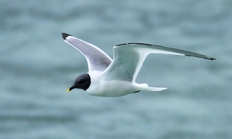
These small agile gulls are predominantly pelagic, but can often be seen from shore and even idling around lower estuaries. It is found primarily on salt water and does not usually forage in dumps and pastures as most gulls do; rather it stays over open ocean, along beaches and in lower estuaries, sometimes resting on the water or on jetties, sand spits and similar bare areas. They are often attracted to feeding swarms of loons, pelicans, tubenoses and other seabirds. The Black-legged kittiwake is a migrant and winter resident in Oregon along the outer coast and offshore. Peak numbers are
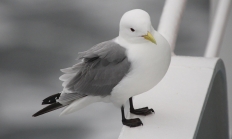
The Caspian tern nests on flat sandy or gravelly areas on islands, or on the margins of lakes, rivers, and marshes. It is always near water, and forages both in nearby water bodies and on prey exposed in nearby open areas. Breeding colonies in recent years have been on islands in the Columbia River east of the Cascades in north central Oregon; Malheur and Harney lakes in southeast Oregon; Summer Lake and lakes in the Warner Valley in south central Oregon. Most colonies have a history of intermittent use. It is a locally common summer resident during breeding season within
